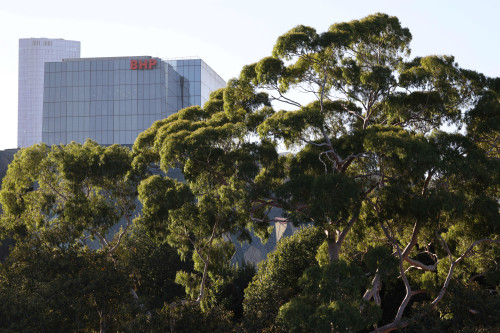By Melanie Burton
MELBOURNE (Reuters) – The world’s biggest listed miner BHP Group considered spinning off its Australian iron ore and coal divisions as part of a medium-term growth strategy, three sources with knowledge of the matter told Reuters.
As part of a planned focus on future-facing commodities potash and copper, BHP weighed separating out the divisions, as it did with South32 in 2015, with an Australian listing most likely, two of the sources said.
The consideration was underway as BHP was pushing hard to green its business and preparing its bid for Anglo American in 2023 and 2024, they said, asking to remain anonymous because the issue was sensitive.
BHP declined to comment.
Such a move would radically reshape BHP, divorcing it from more than half a century of iron ore mining in Australia, where it was incorporated in 1885. Iron ore accounts for approximately 60% of its profits. Unbundling coal with iron ore would also remove the bulk of its carbon exposure.
BHP would, however, keep its South Australian copper assets, backing its strategy to be a leading supplier of the metal needed for the energy transition.
While BHP opted not to progress with its plans for now, the discussions are an insight into the scale of transformation the miner would consider as it recalibrates its future direction with a change in senior leadership.
Former National Australia Bank head Ross McEwan assumed his role as new BHP chair this week, following the departure of Ken MacKenzie, and the contest for a successor to CEO Mike Henry – in his fifth year in the top job – is about to begin.
Henry and CFO David Lamont, who stood down from the role in February 2024, discussed with investors the plan to separate BHP’s future growth from its declining growth businesses towards the end of the decade.
Ultimately they decided it was not the right time because BHP still required the huge amounts of cash generated by the two Australian divisions to fund capital spending at its Escondida copper complex in Chile and its Jansen potash development in Canada.
BHP’s view was a spin-off of iron ore and coal would generate cash and franking credits that benefit Australian tax-payers, meaning there could be considerable Australian interest in any flotation, one of the people said.
In addition, a freed-up copper and potash unit would have more scope to seek out fresh combinations, such as with Teck Resources, the people said.
The plan was complicated by BHP’s failure to purchase Anglo, which would have bulked up the copper business and helped with cash flow, while the incentive to green its business has become less strong as many corporations across the world step back from environment goals.
That suggests any move down that path may be further off.
“The whole strategy is contingent on copper and potash being self-sustaining businesses, both of which have large capital requirements for at least the next five years,” another of the people said.
(Reporting by Melanie Burton; Editing by Veronica Brown and Barbara Lewis)




